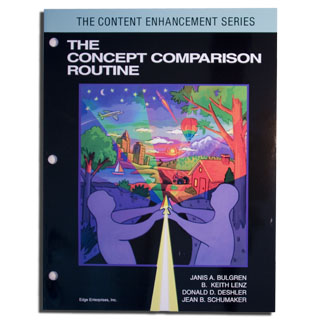
Publication Info: Edge Enterprises, 1995
Concept Comparison Resources:
VIDEO
- 2014 Content Enhancement Devices as Essay Writing Supports - Jan Bulgren Video
- 2013 Content Enhancement Devices as Essay Writing Supports Video
- 2005 SIM Conference Video: CD's: Concept Anchoring, Concept Comparison, Question Exploration, BUILD, LEARN, Taking Notes Together, Strategic Tutoring? VIDEO
- 2006 SIM Conference Video: CDs for Strategic Tutoring, The Concept Routines and Question Exploration Video
- Pre-conference 2010: Enhancing CERS: Guidebooks on Integrating CE Routines in Core and Elective Classes - Bev Colombo, Suzanne Robinson Video
PPTs
- Concept Comparison Routine presentation (ppt) NEW 2021
- Concept Comparison Routine blank devices
- Concept Comparison devices - Minarik (google share, you must log in to google to access)
- Comparison Table google slide: https://docs.google.com/presentation/d/1AcAWH2wgTnL8gnsYyFICApWGGjENYinLgj1PtVFiQjY/copy?usp=sharing
MORE
- Access Florida SPDG LiveBinder Assets (Key: CE CC)
- Access Content Enhancement Routine Checklists
- Description of Concept Comparison Routine from the SIM website
- Self-Guided Professional Development with the CC Multi Media Program, Guidebook and Coaching
- PD Packet
- A different overview ppt
- Try Some Concept Ladders/Pyramids for your Own Content Area activity
- Notes on the Concept Comparison Routine
MICROCREDENTIALS
Stratenotes and Strategram
- Strategram Vol. 14, No. 4, June 2002: Concept Comparison
- Stratenotes Vol. 7, No. 7, April 1999: Comparing the Concept Routines
- Strategram Vol. 20, No. 4, Concept Comparison e-Learning Program
- Description of the Concept Anchoring Routine from the SIM website
Assets from FLORIDA SPDG Livebinders:
Teacher can access Florida Live Binder assets. Share this link and password:
https://www.livebinders.com/play/play_shared_binder/800257?play_view=play Password CE CC
- Cue Do Review
-
The overall instructional process that guides use of the CE device with the Routine’s Linking Steps. This instructional process involves:
Cue: teacher announces the CE routine and explains its use, how it will help students and expectations for student participation
Do: teacher and class collaboratively construct the device using the Linking Steps that “connect” the content to the needs and goals of students
Review: Information presented in the device is reviewed and confirmed, use of the device is reviewed and confirmed, use of the device as a learning and study tool is modeled
- The Routine
-
Teaching ppt (pdf)
The Concept Comparison Routine gives teachers an instructional tool that trumps any Venn Diagram. Not only do students learn a systematic process for identifying similarities and differences, but it teaches them how to summarize the key points- the ticket to remembering and applying. This is a great tool for all content areas.
- Device Templates
- Device Checklist
- Examples
- Implementation Checklist
Research
- Concept Comparison Routine Research slide
- Bulgren, J.A., Lenz, B.K., Schumaker, J.B., Deshler, D.D., & Marquis, J.G. (2002). The use and effectiveness of a comparison routine in diverse secondary content classrooms. Journal of Educational Psychology, 94(2), 356-371. This article reports the results of two studies of the Concept Comparison Routine: Study 1 provides evidence that students benefit from use of the routine and graphic organizer device, and Study 2 provides evidence that teachers can learn to use the device quickly.
- Schumaker, J.B., Fisher, J.B., & Walsh, L.D. (2010). The effects of a computerized professional development program on teachers and students with and without disabilities in secondary general education classes. Learning Disability Quarterly, 33, 111-131. Two studies indicate a computerized Concept Comparison Routine professional development program was at least as effective as a face-to-face workshop on measures of teacher learning and student results.
- Bulgren. J., & Scanlon, D. (1997). Instructional routines and learning strategies that promote understanding of content area concepts. Journal of Adolescent & Adult Literacy, 41(4), 292-302. This article provides examples of using content enhancement routines (Concept Diagram, Comparison Table, ORDER) to promote an understanding of middle and secondary school content area concepts.
-
Schumaker, J. B., & Fisher, J. B. (in press). 35 years on the road from research to practice: A review of studies on four Content Enhancement Routines for inclusive subject-area classes, Part I. Learning Disabilities Research & Practice. Advance online publication. 1 -16. https://doi.org/10.1111/ldrp.12258
